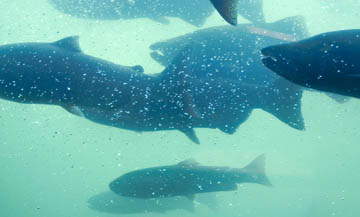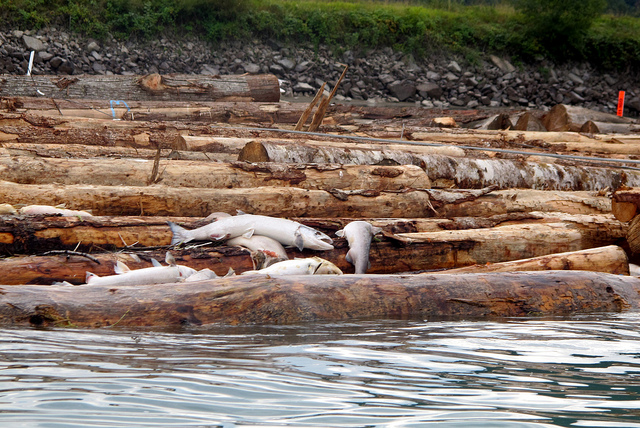
Victoria Times Colonist, December 8, 2012—We’re in Courtenay at the end of this year’s salmon run. We’ve already seen two eagles fly over the Comox Air Force Museum like B-52 bombers with full payloads. From where we stand today on the banks of the Puntledge River, we spot three more birds of prey perched in trees overhead. The seagulls near us are in a post-feast daze, too full to fly, too full to eat.
A few salmon skitter through the shallows, but most lie dead and grey on the gravel bars.
“Such a waste,” says Nature Boy.
Nature Boy, decrying the natural cycle of life and death and organic matter! Can it be?
Then he says, quite testily, “Yes, yes, I know it’s not a waste. I was just thinking of how much salmon costs at the grocery store.”
These stinky fish corpses are—thank goodness!—food for thought today, not food for us. Instead, they’ll be feeding the forest around us. The salmon spend four years at sea gulping down ocean nutrients, then return to the river to spawn and die. Eagles, gulls, bears and other scavengers eat the ocean-fed carcasses, carrying them deep into the bush. There, what remains fertilizes the forest.
During the last decade, researchers at the University of Victoria have discovered salmon-derived nitrogen in trees, shrubs, moss, beetles and other insects. They’ve even found it in the feathers of songbirds that feast on the insects that feast on dead salmon.
Their work tracking salmon-nutrient cycling through coastal forests parallels research by others into how corn nutrients filter through the human food chain. Salmon confers a unique signature on its nitrogen. Carbon from corn likewise carries a molecular label that shouts “Corn!” to those equipped to read it. It shows up in corn-fed animals and in animals that eat corn-fed animals.
Including us. We North Americans nibble nachos and niblets like nobody’s business. We ingest dextrose, lecithin, high-fructose corn syrup, and other unpronounceable corn products. We feast on corn-fed beef, pork, and poultry, and on eggs, milk and cheese from those animals.
Apparently, as much as half of the carbon in the typical North American is corn carbon.
But there’s more about the food we eat staying with us and within us. Scientists in China have discovered genetic material from rice and vegetables circulating in the blood and tissues of humans and other animals.
If nutrients such as nitrogen and carbon are a body’s most basic ingredients, then genetic material provides the blueprint that dictates an organism’s design and the processes for assembling and maintaining an organism out of that raw “stuff.”
The genetic material in question here is microRNA. Ribonucleic acid—RNA—is critical to gene coding, decoding, control and expression. MicroRNAs—tiny snippets of RNA—help control cellular production of proteins, which do most of a cell’s work. The snippets amplify or dampen protein production, thereby affecting cell function and, thus, an organism’s development and health.
The researchers found 30 kinds of plant microRNAs in human and mouse blood and cells. The microRNAs come from rice, broccoli, cabbage and other vegetables.
The scientists are still determining how the plant molecules interact with animal genes, but some are apparently similar enough to mammal microRNA and abundant enough to affect protein production within our own cells.
Clearly, we have to watch what we eat. Literally. While it is inside us.
All this goes to show we each carry within us ghosts of repasts past, rattling our chains of DNA and RNA, haunting our health, and directing our cellular mechanisms into the future in ways we haven’t yet imagined.
It’s something to contemplate as the eagles and seagulls on the Puntledge River finish their feasting season and we embark on our own. With each mouthful, we will become those mouthfuls: ham, cheese, chicken, turkey, tart, fruit.
Nuts!
And because the pigs that become the ham we eat eat corn, and the cows that provide the milk that becomes the cheese we eat eat corn and the turkeys that become the drumsticks and leftovers we eat eat corn, we will remain corn-y, too.
… With a side of rice and veg.
… And salmon, too.
A version of this article appeared in the Victoria Times Colonist….
 River levels in southern B.C. are low, and their temperatures are warmer than normal. Fish are seeking shelter in deeper, larger, cooler pools wherever they can. With fish pooled in creeks and rivers, disease spreads more readily, and predators have an easier time making their catches of the day.
River levels in southern B.C. are low, and their temperatures are warmer than normal. Fish are seeking shelter in deeper, larger, cooler pools wherever they can. With fish pooled in creeks and rivers, disease spreads more readily, and predators have an easier time making their catches of the day.






